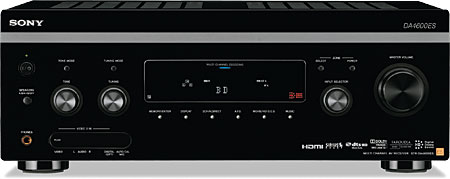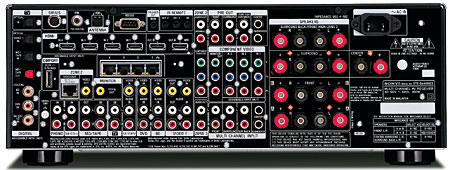Sony STR-DA4600ES A/V Receiver
Sony Goes It Alone

Sony recently announced that it would begin selling its ES products only through A/V specialty retailers, from Best Buy’s Magnolia down to smaller independent retailers. No longer will you find these products online, not even through Sony’s own sonystyle.com. This will give Sony more control over pricing. More important to the consumer is the fact that Sony is reorienting its better AVRs to retailers who can give convincing demos and cater to the needs of custom installation and higher-end home theater.
Upperclassman
Like Pioneer, Sony has two classes of AVRs. The more performance-oriented line is called ES, as are all of the company’s higherend audio products. The STRDA4600ES ($1,500) falls between the STR-DA5600ES ($2,000) and the STR-DA3600ES ($1,100).
All of these ES models are 3D capable with HDMI 1.4a connectivity. That includes 3D passthrough and the Audio Return Channel. Video processing is Faroudja with DCDi.
The ES A/V receivers support IP functionality via DLNA (the Digital Living Network Alliance) certification. The top model (not reviewed here) can be a DLNA server, while the others are DLNA clients. Broadband music features include the music subscription service Rhapsody and SHOUTcast for Internet radio.
ES AVRs are control savvy. They can accommodate Control4, Crestron, AMX, Savant, Universal Remote Control, RTI, and other touchscreen interfaces via IP, RS232, or IR. You can use an iPhone or iPod touch as a remote in addition to the two conventional remotes that Sony supplies with the unit (the extra one is for zonetwo use). The AVR’s PlayStation-like graphic user interface is elegant, although I wish you didn’t have to step down through every menu item to get to Settings at the bottom.
The STR-DA4600ES isn’t especially big or bulky. Its elegant step-down front panel, which echoes other Sony products, features four knobs, for volume, input, tone, and tuning. On the back panel are four HDMI inputs and two outputs for the well-to-do with a front PJ and a flat screen. Throw in component video, and you can connect up to three HD displays. For legacy sources, there’s no S-video but plenty of composite video. Sony goes hog-wild on Ethernet jacks, providing a row of four. This could accommodate your broadband router plus three additional IP-enabled devices such as a Blu-ray player, PS3, set-top box, etc. Sony also supplies an IR blaster, a nice touch, as well as a multichannel analog input and preamp outputs.

Multizone features abound. This AVR can support second-zone A/V with onscreen display and upconversion—there’s another RJ-45 jack specifically for 1080i component video to a second zone—plus thirdzone audio.
Sony supplies a Setup Manager PC application with the STR-DA4600ES on CD-ROM. You can use it to configure the AVR and save your settings as a backup. It’s for Windows only.
For automatic setup and room correction, Sony offers its proprietary DCAC (Digital Cinema Auto Calibration). This is the only auto setup program that’s ever serenaded me with a merry tune before doing its work. There are four DCAC parameter modes: Full Flat, for accurate frequency response from all speakers; Engineer, for frequency response that matches the Sony listening-room standard; Front Reference, with all other speakers matched to the front ones; and Off. DCAC allows up to three measuring positions, which then become user selectable.
DCAC includes an Automatic Phase Matching circuit, which corrects differences in speaker crossovers. It adjusts the center, side-surround, and back-surround channels—but not the front left/right, which are presumed to be the reference. If you step up to the STR-DA5600ES, DCAC can perform speaker relocation, making it seem as if all your speakers are in the right places even if they aren’t.
I used DCAC in my listening demos, and it sounded good. However, some aspects of its operation didn’t produce the results I’ve come to expect from, say, the Audyssey auto setup that several other manufacturers use. Speaker distances were a little off, so I tweaked them manually. As with most auto setups, I also changed my speaker size from large (DCAC accurately detected them as full range) to small (with a sub crossover of 80 hertz).
Despite its price, this AVR doesn’t offer any of the new generation of licensed low-volume listening modes: Audyssey Dynamic EQ/Volume, THX Loudness Plus, or Dolby Volume. I’d call this a major omission. It does offer a Dynamic Range Control, which operates only with Dolby Digital signals. This old-fashioned feature has languished in many AVR brands for many years. The Sony also has a proprietary Night Mode that firmed up dialogue intelligibility at low volumes with two modes, on and off.
Associated equipment included five identical Paradigm Reference Studio v.4 speakers, a Paradigm Reference Seismic 110 sub (used with the Sony’s EQ, not the sub’s), OPPO BDP-83SE universal disc player, Rega Planar 25 turntable, Shure M97xE cartridge, and Onix OA 21S integrated amplifier used only for its phono stage (phono in, line out). All movie demos were Blu-ray Discs.
Pick a Mode, Not Any Mode
I performed all of my demos with DCAC and APM (Automatic Phase Matching) on and in AFD Auto mode. (AFD stands for Auto Format Direct—Sony wisely dedicates a front-panel button to it.) In other words, I ran Sony’s room correction, but with a listening mode that added nothing to the surround soundtracks encoded into movie material. For music material, I did use some postprocessing modes.
In Stolen, Jon Hamm is a cop and father who searches the past for his long-missing son. This moving and disturbing story gets full support from its DTS-HD Master Audio soundtrack. The clarity of vocals, layering of music and effects, and feel of the orchestral score were all spot on. At the 80-Hz sub crossover I typically choose for the Paradigms, male voices coming out of the speakers were well integrated with their low-frequency components coming out of the sub. I made a minor reduction in sub volume as the movie progressed. That is not unusual.





























































